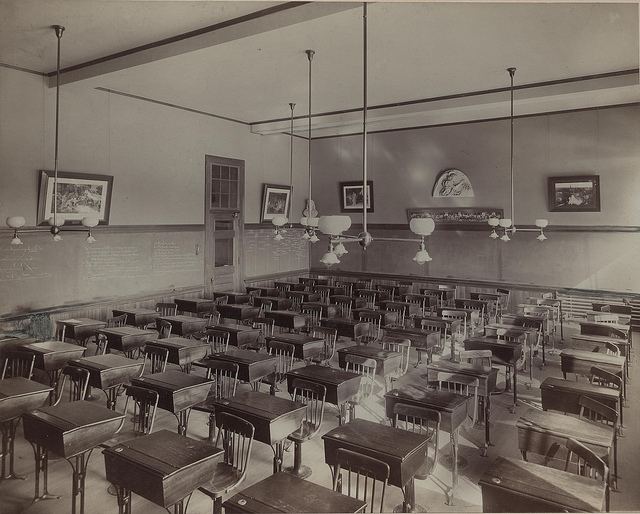The issue: Gaps in student achievement often fit familiar patterns. Children from wealthy families generally perform better on tests than students from poorer families; white students tend to do better than black or Hispanic students.
The differences can be stark. Researchers have found a high correlation between poverty and race in America. Most black and Hispanic students attend schools where the majority of other students are black and Hispanic, according to a 2012 study in the peer-reviewed journal Education Policy Analysis Archives. These schools often have fewer resources than schools where most students are white.
Such disparities are a common topic of political discourse. But policymakers often do not ask how the public feels about the problem — even though public opinion, which shapes lawmakers’ priorities, has policy implications.
An academic study worth reading: “The Politics of Achievement Gaps: U.S. Public Opinion on Race-Based and Wealth-Based Differences in Test Scores,” published in Educational Researcher, 2016.
Study summary: Jon Valant of Tulane University and Daniel A. Newark of the University of Southern Denmark examine the American public’s political will for addressing three persistent gaps in test scores: white students do better than African-Americans, white students do better than Hispanics and wealthier students do better than poorer ones. To that end, Valant and Newark carry out a randomized experiment on a national sample of adults collected by YouGov, the polling firm.
The authors randomly assign a final sample of 1,000 respondents to answer questions about one of the three achievement gaps and then compare responses across the three groups answering questions. The authors ask how important it is to close that particular gap and how important closing the gap is compared to solving a more abstract issue in a distant school district. They also ask respondents to rank four choices that explain the gap. Finally, they ask how respondents feel about specific proposals that would cost taxpayer dollars or commit resources — such as the best teachers — to the neediest students.
Key findings:
- 64 percent of U.S. adults say it is “essential or a high priority” to close the wealthy-poor test gap; 36 percent say the same of the gap between black students and white students; 31 percent say so for the Hispanic-white student gap.
- Respondents are “consistently more concerned” about wealth gaps and offer greater support for proposals targeting wealth gaps than they do for gaps in achievement between white and minority students. They are also better able to explain the causes of wealth gaps. This may be because more Americans are able to imagine themselves facing poverty, but less able to empathize with another race. In response, the authors make a policy interpretation: “Race-neutral initiatives that disproportionately benefit minority children are more politically viable than initiatives that overtly favor racial or ethnic minorities.”
- Black respondents said that closing the black-white gap is a higher priority than closing the Hispanic-white gap.
- Respondents of all demographics are more certain when they are asked what causes the poor-wealthy gap than either of the race gaps. “This could indicate that people find the causes of the poor-wealth gap less mysterious than the causes of the black-white and Hispanic-white gaps.” Or “that they find explanations for the black-white and Hispanic-white gaps not provided in this survey more plausible.”
- 44 percent of those commenting on both the black-white and Hispanic-white test gaps said that the gaps could not be explained by “discrimination or injustice.” About 10 percent of these groups “attributed a great deal of the gap” to “discrimination or injustice.”
- By contrast, 21 percent commenting on the poor-wealthy gap attributed it to “discrimination or injustice.”
- Respondents self-identifying as Democrats are significantly more likely to prioritize closing test gaps than those identifying with other parties. Hispanic and black people are more likely than white people to prioritize closing the race gaps.
- Those who are more convinced a gap is due to “discrimination or injustice” were more likely to feel that gap should be closed.
Other helpful resources:
- The National Center for Education Statistics (NCES), part of the U.S. Department of Education, has released multiple reports looking at achievement gaps among white students and minority students on a standardized test called the National Assessment of Educational Progress, or NAEP.
- The NCES also regularly compiles reports on the demographics of public school students nationally. Here is a report updated in May 2016 that examines the race and ethnicity of students.
- The U.S. Census Bureau offers a variety of detailed reports on student demographics, including family income levels, among preschools, public schools and private schools.
- Stanford University’s Educational Opportunity Monitoring Project focuses on, among other things, racial and ethnic achievement gaps.
- The College Board, which administers the SAT college-entrance exam, tracks student performance on the SAT by gender, race and ethnicity. The College Board also breaks Hispanic students into subcategories so policymakers and the public can gauge the performance of Mexican-American and Puerto Rican students as well as those from Latin America, Central America and South America.
Related research:
- A 2015 study from scholars at Harvard University, the University of Arkansas and the University of Colorado at Colorado Springs finds that black students do better in math and reading when assigned to black teachers.
- A 2015 study in JAMA Pediatrics looks at the how poverty affects children’s brains.
- A 2012 paper in Education Policy Analysis looks at “funding disparities and the inequitable distribution of teachers.”
- In 2015, Educational Researcher published a paper that assessed teacher quality as a factor in closing the achievement gap.
- Journalist’s Resource has reviewed research on how public opinion on education policies and public leaders is impacted by student test data.
Keywords: achievement gap, inequality, race, poverty, failing schools, education standards


Expert Commentary